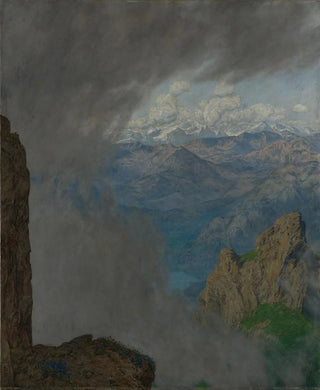Art print | View from the Pilate - Hans Thoma


View from behind

Frame (optional)
Vue from the Pilate - Hans Thoma – Captivating Introduction
In the rich and diverse panorama of art history, some works manage to capture the essence of a moment, a place, or a feeling with such intensity that they become timeless. "Vue from the Pilate - Hans Thoma" is one of those pieces that transcends eras, offering a fascinating glimpse into natural beauty and the harmony between man and his environment. This canvas, with its vibrant color palette and serene atmosphere, invites the viewer to a deep contemplation. It evokes not only a landscape but also a reflection on spirituality and nature—a dialogue between art and life.
Style and uniqueness of the work
The strength of this piece lies in its ability to combine realism and impressionism. Hans Thoma, as a master of landscape painting, manages to capture light in a way that brings each element of the composition to life. The majestic mountains, changing skies, and delicate nuances of the trees intertwine to create an almost dreamlike atmosphere. The way Thoma plays with shadows and light allows one to feel the depth of the landscape, while offering a sense of calm and peace. Every brushstroke seems to tell a story, inviting the observer to immerse themselves in a world where nature and the human spirit coexist in harmony. This work is a true ode to the beauty of the natural world, revealing the singularity of Thoma's artistic vision.
The artist and his influence
Hans Thoma, born in 1839, is an emblematic figure of 19th-century German art. His artistic journey is marked by a deep attachment to nature and a desire to depict the beauty of the world around him. Influenced by the artistic movements of his time, Thoma developed a personal style that blends tradition and innovation. His work is imbued with a palpable spirituality, often inspired by folkloric and mythological themes. Thoma also played a key role in the development of the New Objectivity movement, which aimed to represent reality more directly and authentically. His influence extends beyond his era, inspiring many contemporary artists who

Matte finish

View from behind

Frame (optional)
Vue from the Pilate - Hans Thoma – Captivating Introduction
In the rich and diverse panorama of art history, some works manage to capture the essence of a moment, a place, or a feeling with such intensity that they become timeless. "Vue from the Pilate - Hans Thoma" is one of those pieces that transcends eras, offering a fascinating glimpse into natural beauty and the harmony between man and his environment. This canvas, with its vibrant color palette and serene atmosphere, invites the viewer to a deep contemplation. It evokes not only a landscape but also a reflection on spirituality and nature—a dialogue between art and life.
Style and uniqueness of the work
The strength of this piece lies in its ability to combine realism and impressionism. Hans Thoma, as a master of landscape painting, manages to capture light in a way that brings each element of the composition to life. The majestic mountains, changing skies, and delicate nuances of the trees intertwine to create an almost dreamlike atmosphere. The way Thoma plays with shadows and light allows one to feel the depth of the landscape, while offering a sense of calm and peace. Every brushstroke seems to tell a story, inviting the observer to immerse themselves in a world where nature and the human spirit coexist in harmony. This work is a true ode to the beauty of the natural world, revealing the singularity of Thoma's artistic vision.
The artist and his influence
Hans Thoma, born in 1839, is an emblematic figure of 19th-century German art. His artistic journey is marked by a deep attachment to nature and a desire to depict the beauty of the world around him. Influenced by the artistic movements of his time, Thoma developed a personal style that blends tradition and innovation. His work is imbued with a palpable spirituality, often inspired by folkloric and mythological themes. Thoma also played a key role in the development of the New Objectivity movement, which aimed to represent reality more directly and authentically. His influence extends beyond his era, inspiring many contemporary artists who






